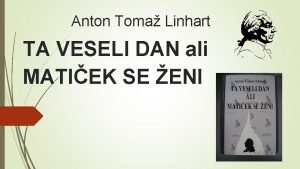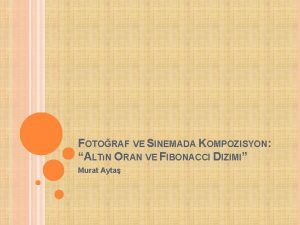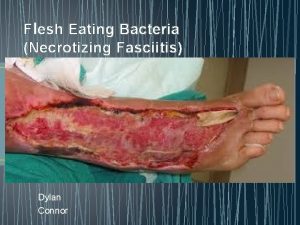Necrotizing Fasciitis ALTIN VESELI What is Necrotizing Fasciitis











- Slides: 11

Necrotizing Fasciitis ALTIN VESELI

What is Necrotizing Fasciitis? • Hippocrates in the 15 th century BC, spoke of it as a complication of erysipelas. • Flesh eating bacteria • Group A streptococcus(Streptococcus pyogenes), Staphylococcus aureus, Clostridium perfringens. • Type 1 (Polymicrobial), Type 2 (Monomicrobial)

Erysipelas: Red Skin

How does it work? • Bacteria enter the body through a break in the skin • Paper cuts, Scrape, Burn, Surgical wound. • Progresses very rapidly • Immunosuppressed individuals(diabetics, elderly, liver disease, AIDS, chemotherapy) • Healthy, strong immune system, practice good hygiene and proper wound care.

Diagnosis • The Laboratory Risk Indicator for Necrotizing Fasciitis (LRINEC) score • It uses 6 serologic measures: C-reactive protein, total WBC count, hemoglobin, creatinine and glucose. • <6 indicates that necrotizing fasciitis should seriously be considered. • >6 Higher rate of mortality and amputation.

Symptoms • • Similar and difficult to differentiate from cellulitis Severe pain in the affected area. Redness, Swelling, Hot skin Fever, Chills, Fatigue may follow the initial wound or soreness. • Skin discoloration(violet), blisters, discharge of dish-water like fluid.

Patient developed rapidly progressive painful erythema and edema following a bee sting. Necrotizing fasciitis was diagnosed.

Patient in the healing process

Treatment • Early diagnosis=Early treatment • Intravenous antibiotic therapy(piperacillin/tazobactam, vancomycin, and clindamycin) • Intravenous immunoglobulin • Surgery(depridement) • Amputation of affected limb • Hyperbaric oxygen therapy

Notable cases • 2004: Eric Allin Cornell, winner of the 2001 Nobel Prize in Physics, lost his left arm and shoulder to the disease. • 2012: Aimee Copeland, a 24 -year-old graduate student, contracted necrotizing fasciitis after she fell from a zip-line into the Little Tallapoosa River which caused a deep cut in her leg. Copeland’s entire leg was amputated along with her other limbs as a side effect of the disease and treatment. Five of her organs also failed as a result of the ordeal.

References • https: //en. wikipedia. org/wiki/Necrotizing_fa sciitis • http: //www. cdc. gov/features/necrotizingfas ciitis/ • http: //www. medscape. com/viewarticle/444 061_4 • http: //www. medicinenet. com/necrotizing_f asciitis/page 3. htm
 Necrotizing fasciitis hemorrhagic bullae
Necrotizing fasciitis hemorrhagic bullae Lrinec score wikipedia
Lrinec score wikipedia Necrotizing ulcerative gingivitis
Necrotizing ulcerative gingivitis Nec diagnosis
Nec diagnosis What is nec in babies
What is nec in babies Ta veseli dan dramski trikotnik
Ta veseli dan dramski trikotnik Ta veseli dan ali maticek se zeni
Ta veseli dan ali maticek se zeni Bajanje na badnjak
Bajanje na badnjak Matiček se ženi osebe
Matiček se ženi osebe Oš nikole tesle mirkovci
Oš nikole tesle mirkovci Altın manyetik alanı biraz sıklaştırır mı
Altın manyetik alanı biraz sıklaştırır mı Kadrajın yatay ve dikey olarak üçe bölünüp
Kadrajın yatay ve dikey olarak üçe bölünüp





















